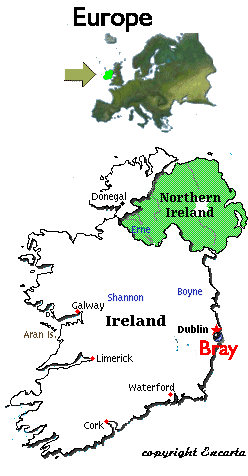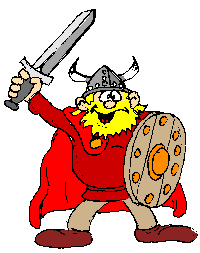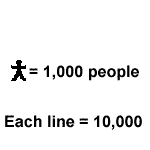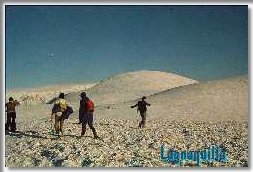

St. Cronan is reputed to have been the hermit who baptised the child who later became St. Kevin of Glendalough. He foretold a great future for Kevin in developing faith and learning. There are obvious parallels with our role in the Bray community.

St. Cronan's is a primary school for boys with around 360 pupils. The school first opened on 20 July 1820 and was located at Seapoint Road. A new school was opened for increasing numbers in October 1880 in what is now the Little Flower Hall. The school has been in its present location since September 1932. The construction of a new school building (see some photos) within the existing grounds started in 1998 and the St. Cronan's moved in in November 1999.

Bray or Bré; - the name is of uncertain origin, possibly from Brí (a hill) or the name of the
river which passes through the town.
Wicklow or in Irish Cill Mhantáin -

In the average class in St. Cronan's there are about 36 students.
In the whole school there are about 360 pupils.
In the town of Bray there are about 30,000 people.
In Dublin City, just to the north of Bray, there are about 1 million people.
On the island of Ireland there are about 5 million people. Details

At the time of the anglo-norman invasion in 1169 the area around Bray was shared between Domhnall Mac Gilla-Mo-Chouic and the son of the Dublin Viking chief Turchil. In 1173 the area was granted to the Norman Knight Sir Walter de Riddlesford. who built a wooden castle on the main street side of the river. In 1313 the O'Byrnes and the O'Tooles burned the castle. Bray was on the border of the area of English rule (known as the Pale) in Ireland for several hundred years and the castle was manned by the English as a defense against raids. English rule became more established during the 1600s. In 1666, for the first time, a stone bridge across the river was built and, by 1700, 250 people lived in Bray.
Bray is located near three things which influence it strongly

Bray lies at the north eastern edge of the Wicklow Mountains. The seafront promenade ends at the foot of Bray Head which is 600 feet or 200 metres high. Some of the rocks of Bray Head are about 360 million years old. To the west of Bray Head lie the Little and Big Sugarloaf hills which are cone shaped because they are made of quartzite (when old rocks are melted by lava and they cool down again they sometimes turn into  quartzite). Further on the granite hills and mountains begin. These granite mountains were formed about 150 million years ago when molten lava from below pushed up the older rocks (but didn't burst through like a volcano). The lava cooled and the rocks it had forced upwards were worn away by wind, rain frost and ice over millions of years. The mountains we see today are what is left of the granite and have a very different shape to the sugarloafs. The highest mountain in Wicklow is Lugnaquilla at 3,039 feet or 925 metres.
quartzite). Further on the granite hills and mountains begin. These granite mountains were formed about 150 million years ago when molten lava from below pushed up the older rocks (but didn't burst through like a volcano). The lava cooled and the rocks it had forced upwards were worn away by wind, rain frost and ice over millions of years. The mountains we see today are what is left of the granite and have a very different shape to the sugarloafs. The highest mountain in Wicklow is Lugnaquilla at 3,039 feet or 925 metres.
 The effects of the last ice age which ended only 10,000 years ago can be seen all over Wicklow. Some examples are
The effects of the last ice age which ended only 10,000 years ago can be seen all over Wicklow. Some examples are

 Bray's situation beside the Irish Sea (Information on Tides) led to its becoming Ireland's most popular seaside resort particularly from the time the railway from Dublin reached Bray in July, 1854. The promenade (or walk) along the sea was built soon afterwards. Bray remained a popular holiday resort until the 1960s when jets and widespread car ownership allowed people to travel to the Mediterranean or elsewhere abroad or in Ireland. Even today, the seafront in Bray attracts quite a lot of tourists and people from Dublin and around Bray out for a walk or a swim. The sea temperature varies from about 9 Celsius or 45 Fahrenheit at its coldest in February to about 16 Celsius or 57 Fahrenheit in August. You won't see too many people swimming in February!!! When it 's dark you can see two lighthouses, the Bailey (at Howth)
Bray's situation beside the Irish Sea (Information on Tides) led to its becoming Ireland's most popular seaside resort particularly from the time the railway from Dublin reached Bray in July, 1854. The promenade (or walk) along the sea was built soon afterwards. Bray remained a popular holiday resort until the 1960s when jets and widespread car ownership allowed people to travel to the Mediterranean or elsewhere abroad or in Ireland. Even today, the seafront in Bray attracts quite a lot of tourists and people from Dublin and around Bray out for a walk or a swim. The sea temperature varies from about 9 Celsius or 45 Fahrenheit at its coldest in February to about 16 Celsius or 57 Fahrenheit in August. You won't see too many people swimming in February!!! When it 's dark you can see two lighthouses, the Bailey (at Howth)  which flashes once every 15 seconds and the Kish (built on a submerged sandbank) with a double flash every 20 seconds (Which of the two is the lighthouse on the left?). At the northern end of the promenade is a small harbour into which the river Dargle flows. Here live a flock of swans to which lots of children like to feed bits of bread. The Harbour is also the base for Bray Sailing Club
which flashes once every 15 seconds and the Kish (built on a submerged sandbank) with a double flash every 20 seconds (Which of the two is the lighthouse on the left?). At the northern end of the promenade is a small harbour into which the river Dargle flows. Here live a flock of swans to which lots of children like to feed bits of bread. The Harbour is also the base for Bray Sailing Club
Just 13 miles from Bray, Dublin, which was founded over 1,000 years ago by the Vikings, is home to over 1 million people and now stretches out to affect an area up to 30 miles from the city centre. Many people who live in Bray travel to work or study in Dublin.